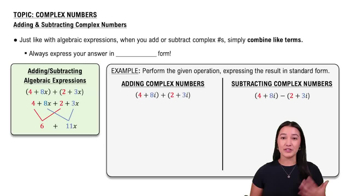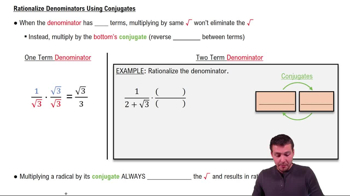Table of contents
- 0. Review of College Algebra4h 43m
- 1. Measuring Angles39m
- 2. Trigonometric Functions on Right Triangles2h 5m
- 3. Unit Circle1h 19m
- 4. Graphing Trigonometric Functions1h 19m
- 5. Inverse Trigonometric Functions and Basic Trigonometric Equations1h 41m
- 6. Trigonometric Identities and More Equations2h 34m
- 7. Non-Right Triangles1h 38m
- 8. Vectors2h 25m
- 9. Polar Equations2h 5m
- 10. Parametric Equations1h 6m
- 11. Graphing Complex Numbers1h 7m
0. Review of College Algebra
Rationalizing Denominators
Problem 141
Textbook Question
Simplify. See Example 9. √3 2 ——— 1 - √3 2
 Verified step by step guidance
Verified step by step guidance1
Recognize that the expression is a complex fraction and can be simplified by rationalizing the denominator.
Multiply both the numerator and the denominator by the conjugate of the denominator, which is \(1 + \frac{\sqrt{3}}{2}\).
Apply the distributive property to both the numerator and the denominator.
Simplify the denominator using the difference of squares formula: \((a - b)(a + b) = a^2 - b^2\).
Simplify the entire expression by performing the arithmetic operations in the numerator and the denominator.
Recommended similar problem, with video answer:
 Verified Solution
Verified SolutionThis video solution was recommended by our tutors as helpful for the problem above
Video duration:
5mPlay a video:
Was this helpful?
Key Concepts
Here are the essential concepts you must grasp in order to answer the question correctly.
Rationalizing the Denominator
Rationalizing the denominator involves eliminating any irrational numbers from the denominator of a fraction. This is typically done by multiplying both the numerator and the denominator by a suitable expression that will result in a rational number in the denominator. For example, if the denominator is of the form 'a + b√c', multiplying by 'a - b√c' can help achieve this.
Recommended video:

Rationalizing Denominators
Simplifying Radicals
Simplifying radicals means rewriting a radical expression in its simplest form. This involves factoring out perfect squares (or cubes, etc.) from under the radical sign. For instance, √12 can be simplified to 2√3, as 12 = 4 × 3, and √4 is a perfect square.
Recommended video:

Simplifying Trig Expressions
Combining Like Terms
Combining like terms is a fundamental algebraic process where terms with the same variable and exponent are added or subtracted. In the context of simplifying expressions, this helps in reducing the expression to its simplest form by merging coefficients of similar terms. For example, in the expression 3x + 5x, the like terms can be combined to yield 8x.
Recommended video:

Adding and Subtracting Complex Numbers

 2:9m
2:9mWatch next
Master Introduction to Trigonometry with a bite sized video explanation from Nick Kaneko
Start learning



